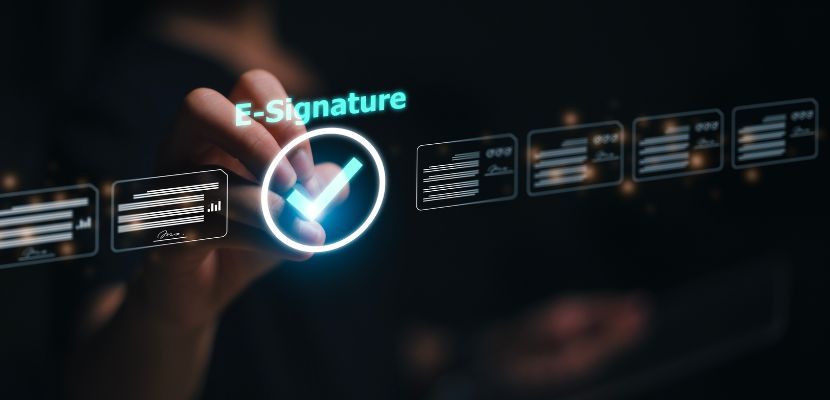A digital signature is a secure and cryptographic method used to verify the authenticity and integrity of digital documents, messages, or transactions.

What Is a Digital Signature?
A digital signature is a cryptographic technique used to validate the authenticity, integrity, and origin of digital data. It operates through a process that involves the use of asymmetric encryption, where a unique pair of keys—a private key and a corresponding public key—work together to create and verify the signature.
The private key, known only to the signer, generates the signature by encrypting a hash value derived from the document or message. The recipient or verifier then uses the associated public key to decrypt and validate the hash, ensuring that the content has not been tampered with and confirming the identity of the signer.
This process not only safeguards data against forgery and alteration but also supports non-repudiation, preventing the signer from denying their involvement. Digital signatures are widely used in electronic transactions, legal agreements, software distribution, and other applications that require secure and verifiable communication.
Digital Signature Example
An example of a digital signature is its use in signing an email to verify the sender's identity and ensure the message has not been altered.
For instance, a company executive sends an important email containing a contract. Before sending, they generate a digital signature using their private key, which encrypts a unique hash of the email's content. The recipient receives the email along with the digital signature and uses the sender's public key to decrypt it. If the decrypted hash matches the hash of the received email, it confirms that the email is authentic, unaltered, and truly sent by the executive.
What Is the Difference Between a Digital Signature and an Electronic Signature?
Here is a table highlighting the differences between a digital signature and an electronic signature:
| Aspect | Digital signature | Electronic signature |
| Definition | A cryptographic technique used to ensure the authenticity, integrity, and non-repudiation of digital data. | A broad term for any electronic method of signing documents or agreements. |
| Security level | Highly secure, as it uses encryption and public key infrastructure (PKI). | Less secure, often relying on email, typed names, or scanned images. |
| Verification | Can be verified through cryptographic algorithms and certificates. | Verification depends on the method used, such as email trails or IP addresses. |
| Legal validity | Legally binding in most countries with specific regulations (e.g., eIDAS, ESIGN). | Legally binding but may require additional authentication for sensitive documents. |
| Use cases | Used for securing financial transactions, contracts, and legal documents requiring high security. | Suitable for less formal agreements like approvals, online forms, and low-risk documents. |
| Technology | Utilizes public and private key pairs for encryption and decryption. | Typically does not use encryption; instead, it captures intent through simpler means. |
| Tamper detection | Detects tampering through cryptographic hash functions. | May lack built-in tamper detection, depending on the implementation. |
| Non-repudiation | Ensures non-repudiation, meaning the signer cannot deny their signature. | May not guarantee non-repudiation without additional verification steps. |
How Does a Digital Signature Work?
A digital signature works by using cryptographic techniques to ensure the authenticity, integrity, and non-repudiation of digital data. It involves three main steps:
Key Generation
A pair of cryptographic keys is created:
- A private key, kept secret by the signer.
- A public key, shared with anyone who needs to verify the signature.
Signing Process
- The signer uses a hash function to generate a unique fixed-length representation (hash) of the document or message.
- This hash is then encrypted with the signer’s private key, creating the digital signature.
- The signature is sent along with the original data to the recipient.
Verification Process
- The recipient uses the signer’s public key to decrypt the signature, retrieving the original hash.
- The recipient then hashes the received document using the same hash function.
- If the computed hash matches the decrypted hash, the signature is valid, proving that the data has not been altered and confirming the identity of the signer.
What Are the Types of Digital Signatures?
Digital signatures can be categorized into three main types based on their level of security and implementation. Each type serves different purposes depending on the level of assurance required.
Simple Digital Signatures (SDS)
A simple digital signature is the most basic form, often used for low-security requirements. It is created without encryption, typically by attaching a scanned image of a handwritten signature or typing a name. While it indicates intent, it does not provide strong authentication or tamper-proof features, making it suitable for informal agreements or low-risk documents where legal and security concerns are minimal.
Advanced Digital Signatures (ADS)
An advanced digital signature is more secure and compliant with legal standards like the eIDAS regulation in the EU. It relies on public key infrastructure (PKI), ensuring that the signer is uniquely identified, and the signature is linked to the document in a tamper-evident way. This type is created using encryption algorithms and a private key, providing higher levels of integrity, authentication, and non-repudiation. It is widely used for contracts, invoices, and legal agreements requiring strict compliance.
Qualified Digital Signatures (QDS)
A qualified digital signature offers the highest level of security and legal recognition. It is created using a qualified certificate issued by a trusted certificate authority and requires a secure device, such as a USB token or smart card, to sign documents. These signatures comply with stringent international standards and provide the highest assurance for identity verification and data integrity. They are ideal for government forms, court documents, and sensitive business transactions where strict authentication and legal compliance are mandatory.
Who Uses Digital Signatures?

Digital signatures are widely used across various industries and by individuals to ensure secure and efficient electronic communications. Key users include:
- Businesses. Companies use digital signatures for securing contracts, invoices, employee agreements, and procurement documents. They streamline workflows, reduce paperwork, and ensure compliance with legal and regulatory standards.
- Government agencies. Governments adopt digital signatures to facilitate secure e-governance services, including tax filing, issuing official documents, and managing interdepartmental communication.
- Healthcare providers. Digital signatures are used to authenticate electronic health records (EHRs), prescriptions, and insurance claims, ensuring data integrity and patient confidentiality.
- Legal professionals. Lawyers and legal firms use digital signatures to sign contracts, affidavits, and other documents, providing tamper-evident records with high legal validity.
- Financial institutions. Banks and financial entities rely on digital signatures for loan approvals, account openings, and secure online transactions to enhance customer trust and operational security.
- Educational institutions. Schools and universities use them for issuing degrees, certifications, and official communications, ensuring authenticity and reducing fraud.
- Individuals. Professionals and freelancers use digital signatures to sign agreements, invoices, and contracts, particularly in remote work and international collaborations.
How to Create a Digital Signature?
Creating a digital signature involves several steps, depending on the tools and software being used. Here's a general process:
- Choose a digital signature tool or software. Select a trusted platform or software, such as Adobe Acrobat, DocuSign, or Microsoft Word, or use a service that provides public key infrastructure (PKI)-based digital signatures.
- Obtain a digital certificate. Acquire a digital certificate from a certificate authority (CA), which verifies your identity and issues the certificate. This step is crucial for legally recognized digital signatures.
- Generate a key pair. Create a public-private key pair using the chosen software or through a CA. The private key is used to sign the document, and the public key is used for verification.
- Upload or open the document. Open the file you want to sign using the selected software. Many tools support PDF, Word, and other common formats.
- Sign the document. Use the software’s signature tool to create and apply the digital signature. The software will encrypt the hash of the document with your private key, embedding the signature into the file.
- Save and share. After signing, save the document and send it to recipients. They can verify the signature using your public key to confirm its authenticity and integrity.
How to Verify a Digital Signature?
Verifying a digital signature ensures that the document has not been tampered with and confirms the identity of the signer. The process generally involves the following steps:
- Open the signed document. Use a compatible software application, such as Adobe Acrobat Reader, Microsoft Word, or a dedicated verification tool that supports digital signatures.
- Check the signature details. Click on the signature or access the signature panel within the software. View details about the signer, including their name, the issuing CA, and the timestamp of signing.
- Validate the certificate. Ensure the digital certificate used to create the signature is valid and issued by a trusted CA. Check whether the certificate is current and has not expired or been revoked.
- Compare the hash values. The software automatically calculates the document's hash and compares it to the hash encrypted in the signature. If the hashes match, it confirms that the document has not been altered.
- Check for warnings or errors. Look for alerts indicating issues with the certificate, such as an untrusted CA or an expired signature. Address these warnings by validating the CA or obtaining updated certificates if needed.
- Review the signature status. Most verification tools display a clear status indicating whether the signature is valid, invalid, or has been modified since signing.
How Do I Send Someone a Digital Signature?
Sending someone a digital signature involves signing the document electronically and securely sharing it. Here’s how to do it:
- Prepare the document. Open the file you want to sign using a compatible tool like Adobe Acrobat, DocuSign, or Microsoft Word. Ensure the document is finalized before signing.
- Apply your digital signature. Use the tool’s digital signature feature to create and embed your signature. If required, upload your digital certificate issued by a certificate authority to verify authenticity.
- Save the signed document. Once signed, save the document in a secure format, such as PDF, to preserve the signature’s integrity.
- Share the document securely. Send the signed file via email, secure cloud storage links, or a document-sharing platform that supports encryption. Ensure the recipient has the necessary tools to verify the signature and instructions if required.
- Include verification details (optional). To simplify the verification process, you can provide instructions on how the recipient can validate the signature or share the public key associated with your certificate.
What Are the Benefits of a Digital Signature?

Digital signatures offer several key benefits, making them a preferred method for secure and efficient document authentication.
- Enhanced security. Digital signatures use encryption and cryptographic algorithms to protect data integrity and ensure that documents cannot be tampered with after signing.
- Authentication and integrity. They verify the identity of the signer and provide assurance that the content has not been altered, ensuring trust in digital transactions.
- Non-repudiation. Digital signatures prevent signers from denying their participation, as each signature is uniquely linked to the signer through a private key.
- Legal compliance. Digital signatures comply with international standards and regulations, such as eIDAS (EU) and ESIGN (U.S.), providing legally binding authentication.
- Time and cost savings. They eliminate the need for printing, scanning, and physical storage, enabling faster processing and reducing operational costs.
- Global accessibility. Documents can be signed and verified remotely, enabling seamless transactions across borders without requiring physical presence.
- Improved workflow efficiency. Automated signing processes simplify document management, approval workflows, and record-keeping, especially in industries like finance, healthcare, and legal services.
What Are the Risks of a Digital Signature?
Digital signatures provide robust security, but they are not without risks. Key concerns include:
- Key compromise. If a signer’s private key is stolen or compromised, an attacker can create fraudulent signatures, potentially leading to unauthorized transactions or data breaches.
- Certificate authority vulnerabilities. Digital signatures rely on trusted certificate authorities to issue certificates. If a CA is hacked or compromised, the integrity of issued certificates could be questioned, affecting trust in signed documents.
- Expiration or revocation of certificates. Digital certificates have expiration dates and may also be revoked due to security concerns. If a certificate is expired or revoked, signatures associated with it may no longer be valid, causing delays or legal issues.
- Phishing and social engineering attacks. Attackers may trick users into disclosing their private keys or accessing fake documents, undermining the authenticity of digital signatures.
- Compatibility issues. Not all systems and applications support digital signatures, leading to verification challenges, especially when sharing documents across different platforms.
- Legal and regulatory variations. Digital signature laws and regulations differ globally, and signatures considered legally valid in one jurisdiction may not be recognized in another, creating compliance risks.
- Reliance on software security. The security of digital signatures depends on the software and tools used to create and verify them. Vulnerabilities in these tools could be exploited to forge signatures or tamper with data.
How to Protect Digital Signatures?
Protecting digital signatures is essential to maintain their security, authenticity, and reliability. Here are key strategies to safeguard them:
- Use strong encryption algorithms. Ensure that the digital signature solution uses advanced cryptographic standards, such as RSA or ECDSA, along with secure hash algorithms like SHA-256 to prevent tampering and unauthorized access.
- Secure private keys. Store private keys in hardware security modules (HSMs), USB tokens, or smart cards to minimize exposure to malware and unauthorized access. Avoid storing them on shared devices or unsecured locations.
- Implement multi-factor authentication (MFA). Require MFA for accessing private keys or digital signature tools to add an extra layer of security against unauthorized access.
- Regularly update certificates. Monitor and renew digital certificates before expiration and replace compromised or outdated certificates immediately to maintain trust and compliance.
- Work with trusted certificate authorities. Obtain digital certificates from reputable CAs that follow industry standards, providing additional validation and security assurance.
- Enable timestamping. Add timestamps to digital signatures to record the exact signing time, ensuring the signature remains valid even if the certificate expires later.
- Monitor and audit activity logs. Maintain logs of signing activities and regularly audit them to detect suspicious behavior or unauthorized attempts to access private keys.
- Educate users. Train employees and users on recognizing phishing attacks, handling private keys securely, and identifying fake certificates or compromised documents.
- Use secure communication channels. Always transmit signed documents over encrypted connections (e.g., HTTPS or VPN) to prevent interception or tampering during transit.
- Backup keys and certificates. Create encrypted backups of private keys and certificates to recover access in case of hardware failure or accidental deletion.
Are Digital Signatures Legal?
Yes, digital signatures are legal and widely recognized as valid forms of electronic authentication in most countries. They are governed by regulations and frameworks that define their use, security standards, and legal enforceability.
In the United States, digital signatures are legally binding under the Electronic Signatures in Global and National Commerce Act (ESIGN) and the Uniform Electronic Transactions Act (UETA). These laws establish that electronic signatures, including digital signatures, carry the same legal weight as handwritten signatures, provided both parties consent to electronic transactions.
In the European Union, digital signatures are regulated by the eIDAS Regulation (Electronic Identification, Authentication, and Trust Services). It distinguishes between advanced and qualified digital signatures, with qualified signatures offering the highest level of legal validity equivalent to handwritten signatures.
Other regions, such as India (Information Technology Act), Australia (Electronic Transactions Act), and Canada (Personal Information Protection and Electronic Documents Act - PIPEDA), also have legal frameworks supporting the use of digital signatures.